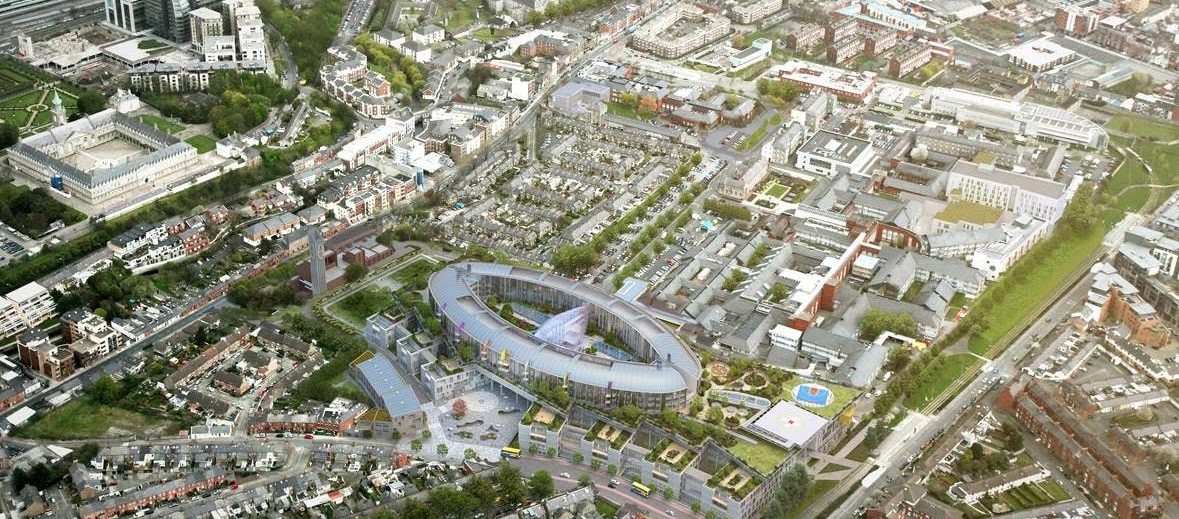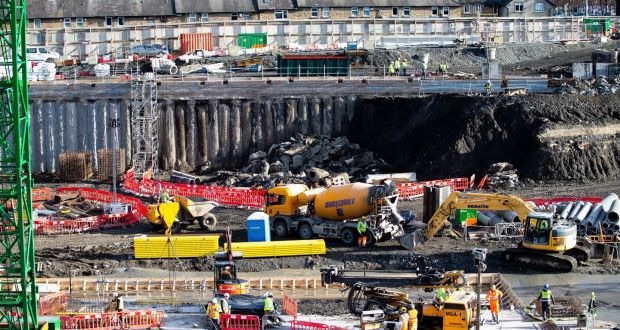Ireland spends less on healthcare as a percentage of GDP than many of the EU2, but it is building what is arguably one of the most expensive hospitals ever constructed.
With an original bid around Eur 650 million (2014), and an explicit increase to around the Eur 1,700 million (2018), some commentators have speculated the final bill could be 2 billion Euros.
This is a staggering sum of money and, compared to the Royal Liverpool rebuild, which shares many of Dublin’s issues including same-site regeneration, despite its own cost escalation it should still come in below the Euro 750 million mark for a 600-bed facility.
Unsurprisingly, even the experts and politicians in Ireland are divided, and as the costs rise the division has become bitter with even the country’s leader upset by the cost overruns, though he was reluctant to point fingers at any single company.
There are one or two contractors who, quite frankly, I would not like to see get a public contract again in this State." Taoiseach Leo Varadkar February 2019 Speaking in the Dáil, the Irish assembly.
Why this has become a must do, literally at all costs, is a result of a population deeply unhappy with its healthcare system:
- Lower than OECD average number of hospital beds1
- Fewer doctors than average in other OECD countries.
- Lower proportion of GDP spent on healthcare than most EU and OECD countries2
- Waiting times in 2015 were the worst in Europe [Euro Health Consumer Index] with little improvement by 2018 when nearly 1 million patients affected 3
- The Health Service Executive accepted that it lacked the capacity to provide sufficiently accessible health services. Reports by patients on waiting times were considerably more pessimistic than official statistics.
- Twenty five percent of the irish population are children under 18 years with obesity (25%) and chronic diseases (16%); 2% are acutely ill or have complex care needs.
- Currently, there is an over reliance on hospital based care, with many services in Dublin accommodated in not fit-for-purpose facilities.
As far as the Irish government is concerned, the Dublin Children’s Hospital is a project that cannot and must not fail.
A world class healthcare facility

The winning design brief from Building Design Partnership in collaboration with O'Connell Mahon, another firm with experience designing hospitals, is smart and evidence based for optimised health outcomes.
The consultation was not only far and wide but also used the extensive healthcare knowledge of these leading firms.
Headline grabbing robots, roof gardens, maximum natural light, short corridors, single ensuite rooms and a fully-digital medical record system will ensure the hospital is built with the future in mind. That is what healthcare development is about, and this is a singularly brave attempt to deliver.
Location, location location

This will be an existing site demolition and build combining the three existing Dublin children’s hospitals co-locating on a campus with St James’s Adult Hospital.
Single-site location for paediatric, adult and maternity services has benefits for infants, children, young people and adults. The breadth and depth of specialties and sub-specialties will be available across the new campus to treat complex conditions.4
Along with a campus wide approach to sharing services and infrastructure, it facilitates the scale and scope for shared learning in clinical practice, research, innovation and education.
A massive advantage of merging three children’s hospitals into one is all the paediatric specialists will be working under one roof. This means children who are very sick, in particular those who have complicated health issues, can be treated without having to go to different hospitals.
Size matters

The new children's hospital will be seven storeys at its highest, with approximately 160,000 m2 of accommodation including the car park.
There will be 6,150 rooms in total including 380 individual inpatient rooms each with an en-suite and a bed for a parent to sleep on. The number of in-patient rooms is comparable to Great Ormond Street Children's Hospital.
It will also have 93 day beds, 22 state-of-the-art operating theatres, including specialised theatres for heart surgery, neurosurgery and orthopaedics.

The surgical areas will have dedicated rooms for emergency and general surgical procedures, as well as, interventional theatres. These facilities will be well positioned to adapt to predicted developments in radiology and other surgical advancements with an MRI scanner for scans during operations so children undergoing surgery can have highly-specialised imaging during their surgery.5
The accommodation includes inpatient rooms for neonatology intensive care, as well as 20 child and adolescent mental health beds for patients with eating disorders and acute mental health services for children.
Separate family accommodation, a dedicated unit with over 50 rooms, is supported by the Ronald McDonald Foundation.
The hospital will have 48,000 lights and 36,000 ICT points. There will be 39 lifts, over 1,000 underground car parking spaces and four acres of outdoor areas, 14 gardens and internal courtyards including a ‘rainbow garden’ which is a central feature of the design, and a ‘meadow garden’. In addition, there will be a hospital school, a third level research facility and specialist therapy and play facilities for children.
We are building a hospital that will “revolutionise” how children’s healthcare is delivered in Ireland. Simon Harris, Minister for Health (2018)
Opposition has focused on location and cost
However there have been many who question the ambition and care with which the project has been managed. Criticisms of the hospital’s site by parent groups, such as Connolly for Kids, believe a more suitable greenfield site can be found on the outskirts of the city along the M50.6
The group argues that many parents and children who must avail of the services are coming from all around the country, and maintain the St James’ site is needlessly dragging them into the busy city centre. When asked about the criticisms, the minister said the St James’ site is the most suitable based on clinical need.

There are fears sick children will be left languishing in ambulances in Dublin traffic if the new children’s hospital is built on the St James’s site, according to a number of rural TDs (MPs). Countless families are saying it is not the right site and many stories circulate about 'sick mothers screaming in the back of ambulances, saying ‘how much longer are we going to be stuck’ and 'they’re just stationary'.
The children of Ireland can’t wait any longer for the new hospital.We have to get on and build this. Simon Harris, Minister for Health (2018)
Whilst most of the location opposition has been swept aside the biggest current issue and one shared by both those for and against the current plan is the cost increase. A motion from the Rural Independent Group had called for the suspension of the proposed National Children’s Hospital project.
Simon Harris has justified this by saying “We are doing an awful lot more than was estimated in that figure, it did not include the hospital school, the third level research centre, the retail and the parking. It didn’t include the equipping and it certainly didn’t include making this Ireland’s first digital hospital.
The increase in cost is also suffering construction inflation, which officials claim has risen from 3% in 2014 to almost 10% in 2018.
The project group who are delivering the project refuted that it will be the most expensive hospital in Europe. They claim costs have been benchmarked against other hospitals built in Europe, the USA and worldwide.
The names of the hospitals benchmarked were not provided and certainly compare unfavourably to the Royal Liverpool same site rebuild which has also had its share of problems resulting from the Carillion collapse and significant build errors.
Some of the funding for operational costs, such as training of staff, as well as some of the HSE ICT needed, is not included in the final figure.The cost of staffing the hospital is also not included. An additional 600 staff will be needed for the day to day running of the children’s hospital in part due to the move to single rooms for inpatients.
There is something rotten here and the Taoiseach mentioned runaway trains. This is a runaway train of costs and a memo from any minister is not going to stop it. Independent TD Mattie McGrath
It is clearly true that costs have come in much higher, some essential aspects were not originally budgeted and the running costs will be significantly more than the existing facilities. So this is the gamble, that it will be all worthwhile and that the extra costs will not deprive other healthcare projects.
Despite the opposition the government has vowed to deliver a world class health facility and much needed boost to the Irish Healthcare system. It may well be worth the high cost to kickstart this rejuvenation but to be truly successful other age demographics in the healthcare system must not suffer and that might mean even higher costs overall.
Background on Irish Healthcare system
Residents are entitled to receive health care through the public health care system, which is managed by the Health Service Executive and mostly funded by general taxation.
Roughly a third of the population qualify for The Medical Card entitling them to free hospital care, GP visits, dental services, optical services, aural services, prescription drugs and medical appliances. It is available to those receiving welfare payments, low earners and a few other cases. All maternity services and child care up to the age of six months are provided free of charge.
All others must pay something towards services. GP visits range from €45-75, a visit to the Accident and Emergency department costs €100. Hospital charges (for inpatients) are a flat fee of €80 per day up to a maximum of €800 in any twelve-month period, irrespective of the actual care received.
Many political parties support extending the availability of the Medical Card to eventually cover everyone who is a resident in Ireland.
Hospitals in Ireland generally offer a full range of healthcare including accident and emergency services. Many hospitals in Ireland, such as Connolly Hospital at Blanchardstown, are operated directly by the Health Service Executive.
There are also hospitals that run on a voluntary basis by organisations who receive public funding but operate with some degree of autonomy. Included in this latter group are teaching hospitals such as University Hospital Galway. There are also many private hospitals.
References
- www.oecd.org/health/health-data.htm
- ec.europa.eu/eurostat/statistics-explained/index.php/Healthcare_expenditure_statistics
- www.irishtimes.com/news/health/almost-a-million-waiting-for-medical-procedures-1.3589171
- www.tuh.ie/Children-s-Services/About-Us/Important-Information-about-the-new-children%E2%80%99s-hospital.pdf
- www.newchildrenshospital.ie/clinical-vision/39-specialties-with-advanced-facilities
- www.thejournal.ie/new-childrens-hospital-3359930-Apr2017




